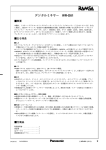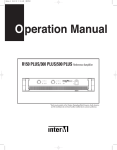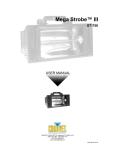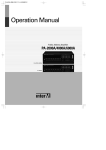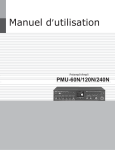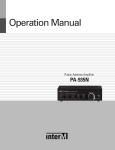Download D.A.S. M-14:2 Specifications
Transcript
OC03 M-14:2 Professional Stereo Mixer ELECTRONICS M-14:2 PROFESSIONAL STEREO MIXER ELECTRONICS Contents Welcome Warning.........................................................................................................................................1 Unpacking ......................................................................................................................................2 Short Form Instructions.....................................................................................................................2 Installation Environment....................................................................................................................................3 Important Safety Instructions.............................................................................................................3 Features............................................................................................................................................4 Front Panel Mono Input Section..........................................................................................................................5 Stereo Input Section .........................................................................................................................8 Master Section ..............................................................................................................................10 Rear Panel Input/ Output Section Connectors A ..............................................................................................13 Input/ Output Section Connectors B ...............................................................................................14 Point to Remember .......................................................................................................................15 Connections ...................................................................................................................................16 Grounding on the Road ..............................................................................................................17 Applications ..................................................................................................................................19 Block Diagram ..............................................................................................................................20 Specifications General Specifications ...................................................................................................................21 Input/Output Specifications............................................................................................................22 Service Procedures....................................................................................................................................23 Schematic .....................................................................................................................................23 Parts List .......................................................................................................................................23 Variations and Options ...............................................................................................................23 Warranty .......................................................................................................................................23 PROFESSIONAL STEREO MIXER Welcome All of the co-workers here at D.A.S ELECTRONICS are dedicated to providing excellent products with inherently good value, and we are delighted you have purchased one of our products. We sincerely trust this product will provide years of satisfactory service, but if anything is not to your complete satisfaction, we will endeavor to make things right. Welcome to D.A.S ELECTRONICS, and thank you for becoming part of our worldwide extended family! CAUTION RISK OF ELECTRIC SHOCK DO NOT OPEN CAUTION: TO REDUCE THE RISK OF ELECTRIC SHOCK. DO NOT REMOVE COVER (OR BACK). This symbol is intended to alert the user to the presence of uninsulated “dangerous voltage” within the product’s enclosure that may be of suf-ficient magnitude to constitute a risk of electric shock to persons. This symbol is intended to alert the user to the presence of important operation and mainte-nance (servicing) instructions in the literature accompanying the appliance. NO USER-SERVICEABLE PARTS INSIDE. REFER SERVICING TO QUALIFIED SERVICE PERSONNEL. WARNING To prevent fire or shock hazard, do not expose the unit to rain or moisture. Caution: To prevent electric shock do not use this (polarized) plug with an extension cord, receptacle or other outlet unless the blades can be fully inserted to prevent blade expo-sure. Attentions: Pour prévenir les chocs électriques ne pas utiliser cette fiche polarisée avec un prolongateur, une prise de courant on une autre sortie de courant, sauf si les lames peuvent étre insérées à fond sans en laisser aucune partie à découvert. *Do not install this equipment in a confined space such as a book case or similar unit. *The apparatus shall not be exposed to dripping or splashing and no objects filled with liquids, such vases, shall be placed on the apparatus. *Worded: “WARNING FOR YOUR PROTECTION PLEASE READ THE FOLLOWING-WATER AND MOISTURE: Unit should not be used near water(e.g. near a bathtub, washbowl, kitchen sink, laundry tub, in a wet basement, or near a swimming pool, etc). Care should be taken so than objects do not fall and liquids are not spilled into the enclosure through openings.” M-14:2 1 PROFESSIONAL STEREO MIXER Unpacking Although it is neither complicated to install nor difficult to operate your set, a few minutes of your time is required to read this manual for a properly wired installation and becoming familiar with its many features and how to use them. Please take a great care in unpacking your set and do not discard the carton and other packing materials. They may be needed when moving your set and are required if it ever becomes necessary to return your set for service. Never place the unit near radiators, in front of heating vents, to direct sun light, in excessive humid or dusty location to avoid early damage and for your years of quality entertainment. Connect your complementary components as illustrated in the following page. Short Form Instructions Thank you for purchasing a M-14:2 Mixing Console. The M-14:2 provides an excellent balance of operability, functionally and ease of use. In order to take full advantage of the M-14:2 capabilities and enjoy years of trouble - free use, please read this manual carefully. 2 M-14:2 PROFESSIONAL STEREO MIXER Installation Environment Never place this product in an environment which could alter its performance or reduce its service life. Such environments usually include high levels of heat, dust, moisture, and vibration. Important Safety Instructions 1. 2. 3. 4. 5. 6. 7. 8. Read these instructions. Keep these instructions. Heed all warnings. Follow all instructions. Do not use this apparatus near water. Clean only with dry cloth. Do not block any ventilation openings. Install in accordance with the manufacturer’s instructions. Do not install near any heat sources such as radiators, heat registers, stoves, or other apparatus (including amplifiers) that produce heat. 9. Do not defeat the safety purpose of the polarized or grounding-type plug. A polarized plug has two blades with one wider than the other. A grounding type plug has two blades and a third grounding prong. The wide blade or the third prong are provided for your safety. If the provided plug does not fit into your outlet, consult an electrician for replacement of the obsolete outlet. 10. Protect the power cord from being walked on or pinched particularly at plugs, convenience receptacles, and the point where they exit from the apparatus. 11. Only use attachments/accessories specified by the manufacturer. 12. Use only with the cart, stand, tripod, bracket, or table specified by the manufacturer, or sold with the apparatus. When a cart is used, use caution when moving the cart/apparatus combination to avoid injury from tip-over. 13. Unplug this apparatus during lightning storms or when unused for long periods of time. 14. Refer all servicing to qualified service personnel. Servicing is required when the apparatus has been damaged in any way, such as power-supply cord or plug is damaged, liquid has been spilled or objects have fallen into the apparatus, the apparatus has been exposed to rain or moisture, does not operate normally, or has been dropped. S3125A S3125A - AVOID EXCESSIVE HEAT, HUMIDITY, DUST AND VIBRATION Keep the unit away from locations where it is likely to be exposed to high temperatures or humidity-such as near radiators, stoves, etc. Also avoid locations which are subject to excessive dust accumulation, or to vibration that could cause mechanical damage. - AVOID PHYSICAL SHOCKS Strong physical shocks to the unit may cause damage. Handle the unit with care. - DO NOT OPEN THE CASE OR ATTEMPT REPAIRS OR MODIFICATIONS YOURSELF This product contains no user-serviceable parts. Refer all maintenance to qualified D.A.S ELECTRONICS service personnel. Opening the case and/or tampering with internal circuitry voids the warranty. - ALWAYS POWER OFF BEFORE MAKING CONNECTIONS Always turn the AC mains OFF before connecting or disconnecting cables. This is important to prevent damage to the unit itself as well as other connected equipment. - HANDLE CABLES CAREFULLY Always plug and unplug cables (including the AC mains power cord) by gripping the connector, not the cord. - CLEAN WITH A SOFT DRY CLOTH Never use solvents such as benzine or paint thinner to clean the unit. Wipe clean with a soft, dry cloth. M-14:2 3 PROFESSIONAL STEREO MIXER Features - 6MONO, 10MONO INPUT AND 4 STEREO INPUT Any sound source of microphones, cassette decks, electronic guitars, organs can be applied to the channel input. - MAIN MIX L/R AND ALT 3/4 OUTPUT Main mix L/R and ALT 3/4 are provided for convenient use. - 2 AUX RETURN AND 2 AUX SEND For convenient use of external equipment, AUX SEND and AUX RETURN function are provided. - CHANNEL EQUALIZER The 3 band equalizer are designed for ±15dB control on mono input channel. The 2 band equalizer are designed for ±15dB control on stereo input channel. - SOLO FUNCTION OF ALL CHs The SOLO function allows you to monitor through headphone outputs and control room outputs any input channel after the channel fader. - PHANTOM POWER(+48V) Phantom power is provided for easy connection of condenser microphones requiring an external power supply. 4 M-14:2 PROFESSIONAL STEREO MIXER Front Panel 1. MONO INPUT SECTION 1 2 3 4 1. MIC INPUT A 3-pin XLR-type connector is used for balanced low impedance microphone inputs. (1: sleeve, 2: hot, 3: cold) Microphones of 50-600Ω line level devices can be connected here. When the PHANTOM switch is turned on, DC +48V will be supplied to pins 2 and 3 of these connectors. It is important that, during operation or testing of the mixer, all channel faders remain fully down whenever the mic input is not properly terminated with a microphone or equivalent 150-ohm source. An open mic invites the introduction of high noise levels which could produce lower quality sound or an incorrect test measurement. 5 PHASE (Normal) 1. GND 2. ( + ) 3. ( ) 2 1 6 PHASE (Reverse) 1. GND 2. ( ) 3. ( + ) 3 7 MIC Input Jack Pin 8 9 2 10 11 +48V 1 2 0V GROUND +48V 3 3 Phantom Power M-14:2 5 PROFESSIONAL STEREO MIXER 2. BALANCED LINE INPUT CONNECTORS A standard 1/4" phone jack is used for balanced or unbalanced line level signals. Examples of line level signals include most electronic keyboards, synthesizers, turn-tables(with appropriate pre-amps), tape decks and the line outputs from other mixers. All input channel controls, including the variable GAIN control. TIP(Hot) SLEEVE(GND) RING(COLD) (1/4" Phone 3 Section Connector) 3. GAIN CONTROL (TRIM) According to the level of the input signal, use this knob to adjust the input to an appropriate level. The best balance of S/N and dynamic range will be achieved if you adjust the TRIM control so that the peak indicator lights occasionally. This control adjusts the channel's mic input sensitivity between -60dB and -16dB and the line input sensitivity between -30dB and +14dB. 4. PEAK LED INDICATOR This LED indicators let you check the level of the signal input to the channel. The peak indicator lights when the input signal reaches 3dB below the channel s clipping point. This indicator show the level of the Post-EQ/ pre-fader signal. If the PEAK indicator lights more than briefly on high-level transients, you should use the GAIN control to decrease the input sensitivity of the channel. If this dose not work, reduce the output level of the connected source. 5. 3BAND EQUALIZER CONTROLS This is a 3-band equalizer with center frequencies, range and type as shown below. The frequency response is flat when the knob is in the "ઓ"position. CONTROL MAX. BOOST/CUT FREQUENCY TYPE HIGH ±15dB 12kHz Shelving MID ±12dB 2.5kHz Peaking LOW ±15dB 80Hz Shelving 6. AUX 1 CONTROLS This knobs control the level of the signals sent to AUX 1 bus. This control is placed before the channel fader, it will be not affected by the channel fader. 7. AUX 2 CONTROLS This knobs control the level of the signals sent to AUX 2 bus. The channel signals mixed by this bus have their overall level set by the AUX 2 SEND Control to the AUX SEND 2 jack on the rear panel. The Aux 2 bus signal is also fed into the internal digital signal processor. Since this control is placed after the channel fader, the signal level will be affected by the channel fader setting. 6 M-14:2 PROFESSIONAL STEREO MIXER આ Modifications Mono channel Aux send 2 are post-fader. This modification changes Aux send2 to be pre-fader instead of post-fader Mono channel. - Aux send2 : post-fader ᆎ pre-fader If you want to convert them, carry out the modification described below to each mono channel you want to be altered. See below figure. 1) Power switch off, Remove AC cord. The work area is on the underside of the PCB board near the channel AUX SEND2 knob. 2) Cut the PCB Line 3) Add a Jumper AUX2 AUX2 POST POST Cut the PCB Line PRE Add a Jumper PRE Before After 8. PAN CONTROL This control pans the channel signal across the master L and R buses, thus determining the perceived position of the sound from that channel in the output stereo sound field. If a PAN control is set all the way to the left, for example, the sound from that channel will be heard from the left speaker system only. If it is set all the way to the right, the sound will be heard from the right speaker system only. Intermediate settings will cause the sound to appear at corresponding locations in the stereo sound field. 9. MUTE/ALT 3-4 SWITCH When the Mute/ALT 3-4 switch is depressed, a channel output will be routed to the ALT 3-4 output instead of the main mix. ALT 3-4 bus offers you a second independent stereo submix with its own submaster stereo fader. 10. SOLO SWITCH When these switch is depressed, the channel input signal can be routed to the solo bus. This switch allows you to monitor the post-fader channel input signal through headphone outputs and control room outs. 11. CHANNEL FADER This is the channels main level control. It determines the level of the signal that is sent from the channel to the master mixing and effect buses. It is the settings of the input channel faders that determine the mix, or the balance of sound levels between the instruments or other sources connected to the inputs. When a channel is not being used, its fader should be set at the minimum position to prevent the addi-tion of unwanted noise to the main program signal. M-14:2 7 PROFESSIONAL STEREO MIXER 2. STEREO INPUT SECTION 1 2 3 4 5 6 7 8 1. STEREO INPUT JACKS These are unbalanced 1/4" phone jacks which input a stereo source with a nominal input and impedance of +4dB/600Ω. If a plug is inserted only in L/MONO, the same signal will be sent to both the L and R buses. The nominal input level for these jacks is -20dB ~ +14dB. 2. GAIN CONTROL (TRIM) According to the level of the input signal, use this knob to adjust the input to an appropriate level. The best balance of S/N and dynamic range will be achieved if you adjust the TRIM control so that the peak indicator lights occasionally. This control adjusts the channel's input sensitivity between 20dB and +14dB. 3. PEAK LED INDICATORS This LED indicators let you check the level of the signal input to the channel. The peak indicator lights when the input signal reaches 3dB below the channels clipping point. This indicator show the level of the post-EQ/pre-fader signal. If the PEAK indicator lights more than briefly on high-level transients, you should use the GAIN control to decrease the input sensitivity of the channel. If this dose not work, reduce the output level of the connected source. 4. 2 BAND EQUALIZER CONTROLS This is a 3-band equalizer with center frequencies, range, and type as shown below. The frequency response is flat when the knob is in the "ઓ"position. CONTROL MAX. BOOST/CUT FREQUENCY TYPE HIGH ±15dB 12kHz Shelving LOW ±15dB 80Hz Shelving 9 10 8 M-14:2 5. AUX 1 CONTROL This knobs control the level of the signals sent to AUX 1 bus. This control is placed before the channel fader, it will be not affected by the channel fader. PROFESSIONAL STEREO MIXER 6. AUX 2 CONTROLS This knobs control the level of the signals sent to AUX 2 bus. The channel signals mixed by this bus have their overall level set by the AUX2 SEND Control to the AUX SEND 2 jack on the rear panel. The aux2 bus signal is also fed into the internal digital signal processor. Since this control is placed after the channel fader, the signal level will be affected by the channel fader setting. 7. BALANCE CONTROL This control adjusts the balance or the L/R position of the stereo input signal. Turning the BALANCE control to the left of center moves the apparent source toward the MAIN MIX L bus, turning it to the right moves the source toward the MAIN MIX R bus. 8. MUTE/ALT 3-4 SWITCH When the Mute/ALT 3-4 switch is depressed, a channel output will be routed to the ALT 3-4 output instead of the main mix. ALT 3-4 bus offers you a second independent stereo submix with its own submaster stereo fader. 9. SOLO SWITCH When these switch are engaged, the channel input signal can be routed to the solo bus. This switch allows you to monitor the post-fader channel input signal through headphone outputs and control room outs. 10. CHANNEL FADER This is the channel s main level control. It determines the level of the signal that is sent from the channel to the master mixing and effect buses. It is the settings of the input channel faders that determine the mix, or the balance of sound levels between the instruments or other sources connected to the inputs. When a channel is not being used, its fader should be set at the minimum position to prevent the addi-tion of unwanted noise to the main program signal. M-14:2 9 PROFESSIONAL STEREO MIXER 3. MASTER SECTION 1. MAIN MIX OUTPUTS These are balanced XLR type output jacks with a nominal output/impedance of +4dB/600Ω. These connectors transmit the MIX L/R outputs to the power amplifiers. which drives the main speakers. ELECTRONICS 2. MAIN INSERT L/R JACKS The insert jack sends one signal to the processing device and inserts the returned signal back into the Left and Right main mix signal paths. The nominal input level and impedance is 0dB/600Ω and the nominal output level and impedance is 0dB/10kΩ 3. CONTROL ROOM OUT JACKS These are unbalanced 1/4" phone jack with a nomina output and impedance of +4dB/600Ω. This is where you connect your control room monitor amplifier inputs. M-14:2 PROFESSIONAL STEREO MIXER 4. AUX SEND 1 ~ 2 CONTROL These controls adjusts the level of the aux send 1~ 2 output. 5. AUX RETURN 1~ 2 CONTROL This control adjusts the input levels from the effect units etc. Connected to the L/MONO, R jacks of AUX RETURN 1~ 2 are sent to the MIX L/R buses. If a plug is inserted into only the L/MONO jack, the same signal will be sent to L/R BALANCE control. 6. TAPE IN CONTROL This control adjusts the level of the playback signal that is inserted to the master mixing bus from the TAPE IN jacks on the top panel. 7. CTRL ROOM CONTROL This is a stereo level control for the studio monitor. This circuit monitors the left/right SOLO buses. 10 M-14:2 PROFESSIONAL STEREO MIXER 8 9 10 11 8. HEADPHONES OUTPUT JACK (1/4" TRS STEREO JACK) These jacks (tip=left, ring=right, sleeve=GND) may be connected to external power amplifiers for headphone distribution, or you can plug our phones directly into the jack. Use only stereo phones! When a mono connector is plugged into the stereo connector, it connects both sides of the headphone amplifier to a single load. In any professional audio system, acci-dents can happen and will have built in protection cir-cuits to assure that momentary problems will not cause failure. However, this circuit will fail in 2-3 minutes if this caution is not observed. 9. POWER INDICATOR This indicator lights when the power switch is turned on. 12 13 14 10. PHANTOM POWER INDICATOR This indicator lights when the phantom power switch is turned on. 11. OUTPUT LEVEL METER A vertical row of ten LED show the continuous output level of main Output L/R or monitor 1/2 by signal select switch. This type of display is free from over shoot problem of mechanical meters and is highly visible under poor lighting conditions. The 0 LED means an output level of +4dB for +4dB output (that s the rated level). 12. SOLO INDICATOR This indicator lights when the solo switch is turned on. (X) (O) (1/4" Phone 3 Section Connector) (1/4" Phone 2 Section Connector) 13. CTRL, HEADPHONE MONITOR SELECTOR These switches select the output signal for the Ctrl room out jack and Phones out jack. Three push buttons to select form the following signal source : Tape in, ALT 3/4, Main mix L/R. M-14:2 11 PROFESSIONAL STEREO MIXER 14. PHONE GAIN CONTROL This control sets the level at the headphone jack. 15. TO MIX SWITCH When this switch is on the signal of each ALT 3/4 will be sent to the MIX L/R buses. 16. ALT 3/4 OUTPUT FADER This fader adjusts the final level of the combined stereo signal and send the ALT 3/4 output jacks. 17. MAIN MIX L/R MASTER FADERS These faders adjust the final level of the combined signals from all channels. 12 M-14:2 PROFESSIONAL STEREO MIXER Rear Panel 1. INPUT/OUTPUT CONNECTORS A 1. CHANNEL INSERT I/O JACK These are input/output jacks located between the head-amplifier and the high pass filter. The nominal input level and impedance is 0dB/600Ω, and the nominal output level and impedance is 0dB/10kΩ. These jacks allow you to own graphic equalizers, compressors, noise filters, or other devices. Tip:Output(Send to external device) Sleeve:Ground Ring:Input(Return from external device) 2. TAPE IN JACKS Used to connect a stereo output device such as external cassette recorder or CD player. The signals which are input here are sent to the ST bus. 3. REC OUT JACKS The REC OUT jacks send the unequalized pre-fader signal from the master bus for recording by the tape deck. M-14:2 13 PROFESSIONAL STEREO MIXER 2. INPUT/OUTPUT CONNECTORS B MODEL NO. M-14 : 2 PROFESSIONAL STEREO MIXER ELECTRONICS 1. POWER SWITCH This switch turns the power ON/OFF. When in the ON position, the power indicator will light. 2. PHANTOM POWER SWITCH When is the ON position, +48V DC phantom power will be provided between pin 2 and pin 3 of the XLRtype jack. If you do not need phantom power, be sure to turn this to the OFF position. 3. ALT 3/4 OUTPUT JACKS These are unbalanced 1/4" phone type output jacks which output the signals of ALT 3/4 buses with a nominal output/impedance of +4dB/600Ω. 4. AUX SEND 1 ~ 2 JACKS These are unbalanced 1/4" phone jacks with a nominal output and impedance of +4dB/600Ω. The AUX SEND 1~ 2 output signal is the sum of all of the input channel AUX SEND 1~ 2 buses. 5. AUX RETURN 1~ 2 JACKS These are unbalanced 1/4" phone jacks with a nominal level and impedance of +4dB/10kΩ. These jacks are usually used to receive the audio returned from an effect unit such as reverb or delay, but they can also be used as supplementary inputs. If a plug is inserted only in L/MONO, the same signal will be sent to both the L and R buses. These allow you to return signal from outboard devices, either in stereo pairs or mono phonically (many popular effects processors provide a single mono input but have a pair of stereo outputs). In practice, you'll probably want to use the Auxiliary returns to bring in signal from connected effect processors. If the effects processors have stereo outputs, they should be connected to both the left and right Auxiliary return inputs so that their stereo integrity is retained. If they have mono outputs, you can route them to either the left or right inputs and then use the Auxiliary return Balance control to adjust the relative level of each paired signal. 14 M-14:2 PROFESSIONAL STEREO MIXER Points to Remember - In all cases, use good quality twin screened audio cable. Check for instability at the output. - Always connect both conductors at both ends, and ensure that the screen is only connected at one end. - Do not disconnect the mains earth from each piece of equipment. This is needed to provided both safety and screen returns to the system star point. - Equipment which has balanced inputs and outputs may need to be electrically isolated from the equipment rack and/or other equipment, to avoid earth loops. It is important to remember that all equipment which is connected to the mains it a potential source of hum and interference and may radiate both electrostatic or electromagnetic radiation. In addition, the mains will also act as a carrier for many forms of RF interference generated by electric motors, air-conditioning units, thyristor light dimmers etc. Unless the earth system is clean, all attempts to improve hum noise levels will be futile. In extreme cases there will be no alternative but to provide a completely separate and independent ‘technical earth’ to replace the incoming ‘noisy earth’. However, always consult your local electricity supply authority to ensure that safety regulations are not being infringed. M-14:2 15 PROFESSIONAL STEREO MIXER Connections D.A.S ELECTRONICS products are wired to reflect accepted wiring practices used throughout the world. Balanced XLR connectors are wired as described: Pin #1 Shield Pin #2 Positive Pine #3 Negative Balanced 1/4" TRS connectors are wired as described: Tip is Positive Ring is Negative Sleeve is Shield Hot (positive) 2 Hot (positive) Cold (negative) 3 Screen 1 Cold (negative) Sleeve Balanced Input Sleeve Screen Return Ring Send Insert Points Tip Sleeve Ring Tip Amp/Line Input 3 Pole (Stereo) Jack Hot (positive) Cold (negative) Screen Sleeve Ring Tip Headphones Left Signal Right Signal Ground Unbalanced Input/Output AUX Send Seeve Tip 2 Pole (Mono) Jack Signal Ground 16 M-14:2 PROFESSIONAL STEREO MIXER Grounding on the Road Many of the above procedures are difficult to use on the road. For example, the telescoping shield concept is nearly impossible to use on a portable cable. Similarly, it is a difficult and time consuming process to search for a water pipe ground every time the system is moved from one performance to another. Yet portable systems can be extremely complex, and may have major grounding problems. The telescoping shield concept can be extended to portable systems by installing a ”ground lift switch” on the output of each device, and on the inputs of devices after the mixer. Since microphones are not grounded except through the mixer, there is on need for an input ground lift switch on most mixers. The diagram below shows a typical ground lift switch installation. By judicious use of these switches, each piece of equipment can be AC grounded for safety without causing ground loops. Because of leakage currents from equipment in the audio system, and in the house, some noise currents can ride on the AC ground wire and are able to enter the audio system. This problem is usually most noticeable with sensitive equipment such as the mixer.Lifting the AC ground at the mixer can often solve this problem. However, lifting the AC ground on the mixer also lifts the AC ground on the microphone chassis, causing a safety hazard. Try connecting the mixer and any other sensitive equipment to other AC circuits. The only other apparent solution to this problem is to eliminate the noise on the AC ground, which is not an easy task. Since it has its own ground, a portable AC power distribution system connected to the house service entrance may be the most effective way to avoid all AC noises. Such a system can be designed and constructed by a qualified electrician; check local electrical codes before each use. USE OF GROUND LIFT SWITCH Balanced Portable Cable with Shield Intact Devices with Balanced Inputs & Outputs Ground Lift Switch Installed in Box or on Rack Panel Main AC Ground Perhaps the best answer to portable system grounding problems, PFI, EMI, and AC noise, is to develop a versatile grounding scheme. Ground lift switches and adapters, and a portable AC power distribution system allow different grounding techniques to be tried easily and quickly when a problem occurs. M-14:2 17 PROFESSIONAL STEREO MIXER CONNECTOR AND CABLE CONFIGURATIONS REMOTE DEVICE DESCRIPTION REMOTE SIDE OF CABLE (Connector Type) CABLE White(Red)/HIGH Black/LOW 2 A. XLR** 2 3 3 Shield/GND (XLR) 1 Floating or Balanced low impedance: most professional equipment line in and line out, microphones. 1 White(Red)/HIGH Black/LOW 2 T R S 3 B. TRS PHONE Shield/GND (XLR) 1 White(Red)/HIGH Black/LOW 2 Unbalanced C. STANDARD low impedance: some PHONE professional equipment and microphones. T S 3 Shield/GND (XLR) 1 White(Red)/HIGH Black/LOW 2 T S D. STANDARD PHONE 3 Shield/GND Unbalanced high impedance: most hi-fi equipment. (XLR) 1 White(Black)/HIGH T Unbalanced high impedance: most hi-fi equipment. E. SHIELD/GND PHONE S S T Shield/GND (Standard Phone) Connector and cable configurations recommended for use with the M-14:2. These cables are based on the use of auxiliary equipment that is isolated from the AC power mains. 18 M-14:2 PROFESSIONAL STEREO MIXER Applications ELECTRONICS M-14:2 PROFESSIONAL STEREO MIXER M-14:2 19 PROFESSIONAL STEREO MIXER Block Diagram 20 M-14:2 PROFESSIONAL STEREO MIXER Specifications................................................. *0dB=0.775Vrms, 0dBV=1Vrms Specifications - GENERAL Maximum Output Level (0.5% T.H.D at 1kHz) +24dB(MIX L/R) @600Ω +20dB(ALT 3/4, AUX1~ 2, CTRL ROOM) @600Ω +20dB(INSERT) @10kΩ More than 100mW(HEADPHONES) @40Ω T.H.D <0.1% @+14dB 20Hz ~ 20kHz (MIX L/R, ALT 3/4, AUX SEND1~ 2, CTRL ROOM) @600Ω Frequency Response 20Hz ~ 20kHz, +1/-2dB (MIX L/R, ALT 3/4, AUX SEND1~ 2, CTRL ROOM) @600Ω Hum and Noise (Average, Rs=150Ω) -127dB equivalent input noise -95dB residual noise (MIX L/R, ALT 3/4, AUX SEND1~ 2, CTRL ROOM OUT) -88dB (MIX L/R, ALT 3/4, AUX SEND1~ 2, CTRL ROOM OUT) * Master fader at nominal level and all channel fader Minimum. Maximum Voltage Gain 84dB MIC IN TO MIX L/R 84dB MIC IN TO ALT3/4 76dB MIC IN TO AUX 1(PRE) 86dB MIC IN TO AUX 2(REV) 90dB MIC IN TO CONTROL ROOM L/R 62.2dB MIC IN TO REC L/R 54dB LINE IN TO MIX L/R 54dB LINE IN TO ALT3/4 46dB LINE IN TO AUX 1(PRE) 56dB LINE IN TO AUX 2(REV) 60dB LINE IN TO CONTROL ROOM L/R 44dB ST IN TO MIX L/R 44dB ST IN TO ALT3/4 16dB AUX RETURN IN TO MIX L/R 27.8dB TAPE IN TO MIX L/R Crosstalk (at 1kHz) -70dB between input channels -70dB between output channels Gain Control(mono Input Channel) 44dB Variable (-60dB ~ -16dB), (-30dB ~ +14dB) Gain Control(stereo Input Channel) 34dB Variable (-20dB ~ +14dB) Input Channel Equalization HIGH: 12kHz shelving, MID : 2.5kHz peaking LOW: 80Hz shelving * Turnover/roll off frequencies: located 3dB below maximum boost/cut LED Meters 10-Segment LEDx2 MIX L/R, ALT 3/4, AUX SEND1 ~ 2, CTRL ROOM Channel Indicators Peak: An indicator for each channel turns on when the pre-channel fader signal is 3dB below clipping. Phantom Power +48V DC Power Source/Power Consumption 100-120VAC or 220-240VAC; 50/60Hz, 30W (Supplied AC mains transformer depends on country requirements) Weight 7kg/15.4lb Dimensions 482(W)x90(H)x354(D)mm/19(W)x3.5(H)x14(D)in M-14:2 21 PROFESSIONAL STEREO MIXER Specifications ..............................................0dB=0.775Vrms, 0dBV=1Vrms - INPUT Input Connector Input Impedance Nominal Impedance Rated Input Level Connector Type XLR 3-31 Type Balanced Phone Jack (TRS) T = Hot R = Cold S = GND Unbalanced Phone Jack Unbalanced Phone Jack Phone Jack (TRS) T = Out R = In S = GND Phone Jack (TRS) T = Out R = In S = GND RCA pin Jack CH Mic 4kΩ 50 ~ 600Ω -60dB CH Line 10kΩ 600Ω -30dB Stereo Input 5kΩ 600Ω -20dB Aux Return 1~ 2 10kΩ 600Ω +4dB Mono Channel Insert Input 10kΩ 600Ω 0dB Main Stereo Insert Input 10kΩ 600Ω 0dB Tape In 10kΩ 600Ω -10dBV Output Impedance Nominal Impedance Rated Output Level Connector type MIX Out L/R ALT 3/4 150Ω 75Ω 600Ω 600Ω +4dB +4dB CTRL Room Out 75Ω 600Ω +4dB Aux Send 1~ 2 75Ω 600Ω +4dB Mono Channel Insert Input 600Ω 10kΩ 0dB Main Stereo Insert Input 10kΩ 600Ω 0dB Rec Out Phones Out 600Ω 100Ω 10kΩ 40Ω -10dBV 3mW XLR 3-32 Type Unbalanced Phone Jack Unbalanced Phone Jack Unbalanced Phone Jack Phone Jack (TRS) T = Out R = In S = GND Phone Jack (TRS) T = Out R = In S = GND RCA pin Jack Stereo Phone Jack - OUTPUT Output Connector * Specifications and design subject to change without notice for improvements. 22 M-14:2 PROFESSIONAL STEREO MIXER Service Procedures Take steps to insure the problem is not related to operator error or other products within the system. Information provided in the troubleshooting portion of this manual may help with this process. Once it is certain that the problem is related to the product contact your warranty provider as described in the warranty section of this manual. Schematic A Schematic is available by contacting your warranty provider. Parts List A Parts List is available by contacting your warranty provider. Variations and Options Variations Products supplied through legitimate sources are compatible with local AC power requirements. Options No optional items are available for this product. Warranty Warranty terms and conditions vary by country and may not be the same for all products. Terms and conditions of warranty for a given product may be determined first by locating the appropriate country which the product was purchased in, then by locating the product type. To obtain specific warranty information and available service locations contact D.A.S ELECTRONICS directly or the authorized D.A.S ELECTRONICS Distributor for your specific country or region. M-14:2 23 NOTE ELECTRONICS Inter-M, Ltd. (Korea) began operations in 1983. Since then, Inter-M has grown to become one of the largest manufacturers of professional audio and commercial sound electronics equipment in the world. Inter-M has gained worldwide recognition for its own branded products, as well as private label manufacturing of electronics sold under other names (OEM). The company is no longer just a Korean company, but rather a global company that is truly international in scope, with factories and offices in Korea and China, and sales and marketing operations located in Japan, Europe, and the U.S.A. With more than 850 employees around the globe, Inter-M is well-poised for further growth and expansion. INTER-M AMERICAS, INC. 1 EAST BEACON LIGHT LANE CHESTER, PA USA 19013-4409 TEL : (610) 874-8870, FAX : (610) 874-8890 Home Page : http://www.inter-m.net, E-mail : [email protected] INTER-M Corporation SEOUL OFFICE:653-5 BANGHAK-DONG, DOBONG-KU, SEOUL, KOREA TEL : 82-2-2289-8140~8, FAX : 82-2-2289-8149 Home Page : http://www.inter-m.com, E-mail : [email protected] MADE IN CHINA December 2003 9007982200 A



























